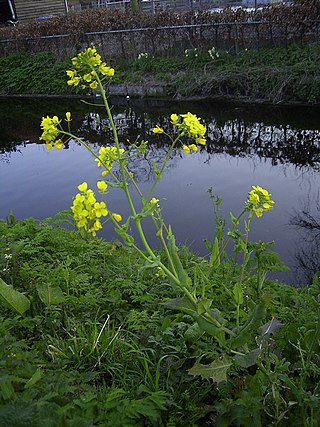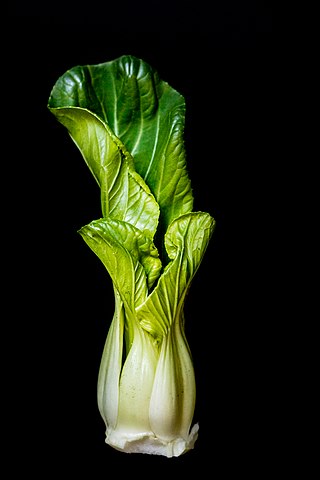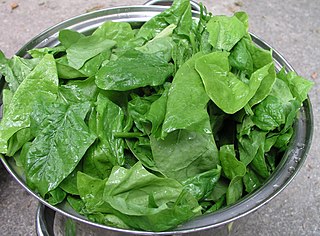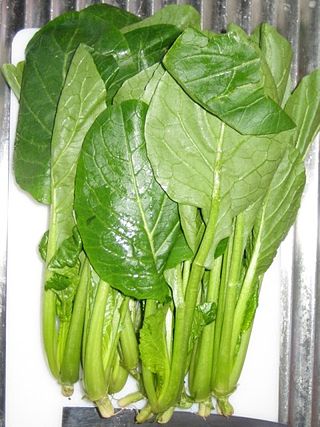| Mizuna | |
|---|---|
 Mizuna | |
| Species | Brassica rapa var. nipposinica |
| Cultivar | Mizuna |
Mizuna (ミズナ(水菜), "water greens"), kyouna (京菜), [1] Japanese mustard greens, [2] [3] or spider mustard, [2] is a cultivar of Brassica rapa var. niposinica.
| Mizuna | |
|---|---|
 Mizuna | |
| Species | Brassica rapa var. nipposinica |
| Cultivar | Mizuna |
Mizuna (ミズナ(水菜), "water greens"), kyouna (京菜), [1] Japanese mustard greens, [2] [3] or spider mustard, [2] is a cultivar of Brassica rapa var. niposinica.

Possessing dark green, serrated leaves, mizuna is described as having, when raw, a "piquant, mild peppery flavor...slightly spicy, but less so than arugula." [4] It is also used in stir-fries, soups, and nabemono (Japanese hot pots).

In addition to the term mizuna (and its alternates) being applied to at least two different species of Brassica , horticulturalists have defined and named a number of varieties. For example, a resource provided by Cornell University and the United States Department of Agriculture lists sixteen varieties including "Early Mizuna", "Kyona Mizuna", "Komatsuna Mizuna", "Vitamin Green Mizuna", "Kyoto Mizuna", "Happy Rich Mizuna", "Summer Fest Mizuna", "Tokyo Early Mizuna", "Mibuna Mizuna", "Red Komatsuna Mizuna", "Waido Mizuna" and "Purple Mizuna". [5] There is also a variety known as pink mizuna. [6]
Mizuna has been cultivated in Japan since ancient times. Mizuna was successfully grown in the International Space Station in 2019. [7] It grows in hardiness zones 4 to 9, prefers full sun or partial shade, well-drained soil and a pH of 6.5–7.0. [8] It can be grown as a microgreen, sowing every 3 cm, or for its leaves with a 20 cm spacing. [9] It is produced by more than 30 countries around the world, but China, Japan, South Korea, India and the United States account for 70% of global production. [10]

The turnip or white turnip is a root vegetable commonly grown in temperate climates worldwide for its white, fleshy taproot. Small, tender varieties are grown for human consumption, while larger varieties are grown as feed for livestock. The name turnip – used in many regions – may also be used to refer to rutabaga, which is a different but related vegetable.

Cabbage, comprising several cultivars of Brassica oleracea, is a leafy green, red (purple), or white biennial plant grown as an annual vegetable crop for its dense-leaved heads. It is descended from the wild cabbage, and belongs to the "cole crops" or brassicas, meaning it is closely related to broccoli and cauliflower ; Brussels sprouts ; and Savoy cabbage.

Broccoli is an edible green plant in the cabbage family whose large flowering head, stalk and small associated leaves are eaten as a vegetable. Broccoli is classified in the Italica cultivar group of the species Brassica oleracea. Broccoli has large flower heads, or florets, usually dark green, arranged in a tree-like structure branching out from a thick stalk, which is usually light green. The mass of flower heads is surrounded by leaves. Broccoli resembles cauliflower, which is a different but closely related cultivar group of the same Brassica species.

Brassica is a genus of plants in the cabbage and mustard family (Brassicaceae). The members of the genus are informally known as cruciferous vegetables, cabbages, mustard plants, or simply brassicas. Crops from this genus are sometimes called cole crops—derived from the Latin caulis, denoting the stem or stalk of a plant.

The radish is a flowering plant in the mustard family, Brassicaceae. Its large taproot is commonly used as a root vegetable, although the entire plant is edible and its leaves are sometimes used as a leaf vegetable. Originally domesticated in Asia, radishes are now grown and consumed throughout the world. The radish is sometimes considered to form a species complex with the wild radish, and instead given the trinomial name Raphanus raphanistrum subsp. sativus.

Rapeseed, also known as rape and oilseed rape, is a bright-yellow flowering member of the family Brassicaceae, cultivated mainly for its oil-rich seed, which naturally contains appreciable amounts of mildly toxic erucic acid. The term "canola" denotes a group of rapeseed cultivars that were bred to have very low levels of erucic acid and which are especially prized for use as human and animal food. Rapeseed is the third-largest source of vegetable oil and the second-largest source of protein meal in the world.

Chinese cabbage is either of two cultivar groups of leaf vegetables often used in Chinese cuisine: the Pekinensis Group and the Chinensis Group.

Rapini is a green cruciferous vegetable, with the leaves, buds, and stems all being edible; the buds somewhat resemble broccoli. Rapini is known for its bitter taste, and is particularly associated with Mediterranean cuisine. It is a particularly rich dietary source of vitamin K.

Bok choy, pak choi or pok choi is a type of Chinese cabbage cultivated as a leaf vegetable to be used as food. Varieties do not form heads and have green leaf blades with lighter bulbous bottoms instead, forming a cluster reminiscent of mustard greens. Its flavor is described as being between spinach and water chestnuts but slightly sweeter, with a mildly peppery undertone. The green leaves have a stronger flavor than the white bulb.

Choy sum is a leafy vegetable commonly used in Chinese cuisine. It is a member of the genus Brassica of the mustard family, Brassicaceae. Choy sum is a transliteration of the Cantonese name, which can be literally translated as "heart of the vegetable". Choy sum is also called yu choy. It is also known as Chinese flowering cabbage.

Leaf vegetables, also called leafy greens, pot herbs, vegetable greens, or simply greens, are plant leaves eaten as a vegetable, sometimes accompanied by tender petioles and shoots. Leaf vegetables eaten raw in a salad can be called salad greens.

Brassica rapa is a plant species that has been widely cultivated into many forms, including the turnip, komatsuna, napa cabbage, bomdong, bok choy, and rapini.

Nozawana (野沢菜), Brassica rapa L. var. hakabura) is a Japanese leaf vegetable, of the brassica family, a form of turnip greens. It is a biennial plant often pickled that has been cultivated in the Shin'etsu region, centered around the village of Nozawaonsen, Shimotakai District, Nagano Prefecture. It is of the same species as the common turnip and one of a Japanese variety of mustard leaf.

The mustard plant is any one of several plant species in the genera Brassica, Rhamphospermum and Sinapis in the family Brassicaceae. Mustard seed is used as a spice. Grinding and mixing the seeds with water, vinegar, or other liquids creates the yellow condiment known as prepared mustard. The seeds can also be pressed to make mustard oil, and the edible leaves can be eaten as mustard greens. Many vegetables are cultivated varieties of mustard plants; domestication may have begun 6,000 years ago.

Brassica juncea, commonly mustard greens, brown mustard, Chinese mustard, Indian mustard, Korean green mustard, leaf mustard, Oriental mustard and vegetable mustard, is a species of mustard plant.

Komatsuna or Japanese mustard spinach is a leaf vegetable. It is a variety of Brassica rapa, the plant species that yields the turnip, mizuna, napa cabbage, and rapini. It is grown commercially in Japan and Taiwan. It is a versatile vegetable that is cooked and eaten in many ways. The plant is also used for fodder in some Asian countries.

Tatsoi is an Asian variety of Brassica rapa grown for greens. Also called tat choy, it is closely related to the more familiar bok choy. This plant has become popular in North American cuisine as well, and is now grown throughout the world.

Rhamphospermum arvense, the charlock mustard, field mustard, wild mustard, or just charlock, is an annual or winter annual plant in the family Brassicaceae. It is found in the fields of North Africa, Asia, Europe, and some other areas where it has been transported and naturalized. Pieris rapae, the small white butterfly, and Pieris napi, the green veined white butterfly, are significant consumers of charlock during their larval stages.

Napa cabbage is a type of Chinese cabbage originating near the Beijing region of China that is widely used in East Asian cuisine. Since the 20th century, it has also become a widespread crop in Europe, the Americas, and Australia. In much of the world, it is referred to as "Chinese cabbage".

The Vegetable Production System (Veggie) is a plant growth system developed and used by NASA in space environments. The purpose of Veggie is to provide a self-sufficient and sustainable food source for astronauts as well as a means of recreation and relaxation through therapeutic gardening. Veggie was designed in conjunction with ORBITEC and went operational aboard the International Space Station in 2014, with another Veggie module added to the ISS in 2017.